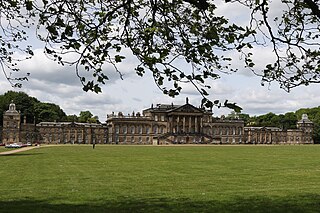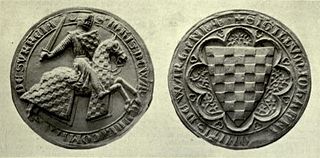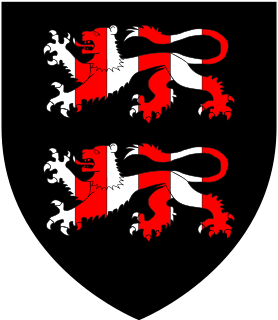Related Research Articles

The Wars of Scottish Independence were a series of military campaigns fought between the Kingdom of Scotland and the Kingdom of England in the late 13th and early 14th centuries.

Wentworth Woodhouse is a Grade I listed country house in the village of Wentworth, in the Metropolitan Borough of Rotherham in South Yorkshire, England. It is currently owned by the Wentworth Woodhouse Preservation Trust. Considered to be the largest private residence in the United Kingdom, it has an east front of 606 feet (185 m); the longest country house façade in Europe. The house has more than 300 rooms, although the precise number is unclear, with 250,000 square feet (23,000 m2) of floorspace. It covers an area of more than 2.5 acres (1.0 ha), and is surrounded by a 180-acre (73 ha) park, and an estate of 15,000 acres (6,100 ha).

Earl of Wharncliffe, in the West Riding of the County of York, is a title in the Peerage of the United Kingdom.

John de Warenne, 6th Earl of Surrey was a prominent English nobleman and military commander during the reigns of Henry III of England and Edward I of England. During the Second Barons' War he switched sides twice, ending up in support of the king, for whose capture he was present at Lewes in 1264. Warenne was later appointed a Guardian of Scotland and featured prominently in Edward I's wars in Scotland.

The title Baron Greystock has been created twice in the Peerage of England. It was first created when John de Greystock was summoned to parliament in 1295.

Earl Fitzwilliam was a title in both the Peerage of Ireland and the Peerage of Great Britain held by the head of the Fitzwilliam family.

William Wentworth-Fitzwilliam, 4th Earl Fitzwilliam, PC, styled Viscount Milton until 1756, was a British Whig statesman of the late 18th and early 19th centuries. In 1782 he inherited the estates of his uncle Charles Watson-Wentworth, 2nd Marquess of Rockingham, making him one of the richest people in Britain. He played a leading part in Whig politics until the 1820s.
Sir John de Benstede KB (c.1275 –1323/4) was a prominent member of the English royal household in the late 13th and early 14th century. He was Prebendary of Sandiacre from 3 February 1297 until, presumably, 1308, when he married. He was also King's Secretary, and he served variously as keeper of the Great Seal and controller of the wardrobe. He also served as Chancellor of the Exchequer from 1305-1306, and as a royal judge from 1309 onwards.
Sir Robert VI de Brus, 6th Lord of Annandale, jure uxoris Earl of Carrick (1271–1292), Lord of Hartness, Writtle and Hatfield Broad Oak, was a cross-border lord, and participant of the Second Barons' War, Ninth Crusade, Welsh Wars, and First War of Scottish Independence.

Elizabeth of Rhuddlan was the eighth and youngest daughter of King Edward I and Queen Eleanor of Castile. Of all of her siblings, she was closest to her younger brother King Edward II, as they were only two years apart in age.
Events from the 1300s in England.

Henry de Percy, 1st Baron Percy of Alnwick was a medieval English magnate.
Sir Robert de Malberthorp was an English lawyer, and Chief Justice of the King's Bench in 1329. He was the son and heir of Sir William of Malberthorpe, lord of the manor of Mablethorpe, Lincolnshire, which was located on the site of the present Mablethorpe Hall.

Milton Hall near Peterborough, is the largest private house in Cambridgeshire, England. As part of the Soke of Peterborough, it was formerly part of Northamptonshire. It dates from 1594, being the historical home of the Fitzwilliam family, and is situated in an extensive park in which some original oak trees from an earlier Tudor deer park survive. The house is a Grade I listed building; the garden is Grade II*.

Sir James Strangeways (1415—1480) was Speaker of the House of Commons of England between 1461–1462. and a close political ally of Edward IV's Yorkist faction.
Thomas Cantock was an English-born cleric and judge in medieval Ireland, who held the offices of Bishop of Emly and Lord Chancellor of Ireland.
Ralph Fitzwilliam, or Ralph, son of William de Grimthorpe, Lord of Greystoke, was a feudal baron with extensive landholdings in the North of England, representative of a manorial lordship seated where Grimthorpe Hill rises to commanding views a mile to the north of Pocklington in the Yorkshire Wolds. He gave sustained military service and leadership through the Scottish and Welsh campaigns of Edward I and was summoned to parliament from 1295 to 1315. His marriage in c. 1282 brought him other manors including Morpeth in Northumberland and its appurtenances. In 1297 he was enfeoffed as tenant-in-chief of the entire barony of Greystoke, seated at Greystoke in Cumberland but with Yorkshire estates, through his matrilineal Greystok descent. He entered upon these in his own right in 1306. Having served in the retinue of Aymer de Valence, during the first decade of Edward II's reign he remained dependable as a military leader and royal lieutenant in the defence administration of the northern counties and Scottish marches. His descendants adopted the Greystoke name, and their inheritance continued in the male line until the end of the 15th century.
Robert Waterton was a trusted servant of the House of Lancaster under three monarchs, Henry IV, Henry V, and Henry VI. As Constable of Pontefract Castle, he had custody of Richard II after that king was deposed.

Ralph de Greystoke, 1st Baron Greystoke, was an English peer and landowner.

The Rockingham Mausoleum, Wentworth, near Rotherham, South Yorkshire, England is a cenotaph commemorating Charles Watson-Wentworth, 2nd Marquess of Rockingham, who was Prime Minister at the time of his death in 1782. The name by which the memorial is now known is in fact a misnomer, since Charles Watson-Wentworth is buried in York Minster. Eighteenth and nineteenth century sources refer to the edifice simply as "the Monument".
References
![]()
This article relies largely or entirely on a single source .(January 2011) |
| This United Kingdom law-related biographical article is a stub. You can help Wikipedia by expanding it. |